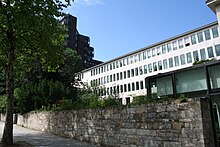Hansakontor
The Hansakontor Dortmund is an office building in the heart of Dortmund city center. As the former administration building of Ruhrkohle AG , it is now accommodation for various younger and established companies from the region. The Hansakontor is directly connected to two streets. On the one hand it has the old entrance to Silberstrasse, on the other hand a new entrance to Hansastrasse has been created, which leads directly through the listed gardens.
history
Originally, the Hansakontor was built by Harpener Bergbau AG for administrative purposes. Until the 1940s, there were residential buildings on today's Hansakontor site, which, according to the planning of Harpener Bergbau AG, should be demolished after the property was acquired. However, the plans were thwarted by the destruction in World War II, to which these residential buildings, which are now used for office purposes, fell victim. After the war and a few other delays caused by the British occupying forces, construction could begin, so that the first phase of construction was completed in 1950. A year later, the building application for the second and final construction phase was submitted.
The outdoor area was also redesigned in the form of a garden. The “Wettersteiger with a raised miner's lamp”, a bronze sculpture by the sculptor Wilhelm Wulff , has stood here since 1958 , which ultimately rounded off the immediate vicinity of the Hansakontor according to the plan by Munich gardener Guido Harbers . In 1968 the Harpener Bergbau AG merged with 25 other companies and became Ruhrkohle AG (RAG), the last owner and user of today's Hansakontor before its renovation.
Right next to the administration building at Silberstrasse 22, the new RAG office building was completed in 1978, which meant that today's Hansakontor had to be reduced in size. Among other things, it lost its lavishly glazed staircase. Until recently, the administration wing remained in use by Ruhrkohle AG despite the new adjacent RAG building.
architecture
The representative area of the Hansakontor is given its own stronger weight in relation to the main beam due to the almost closed walls on the street fronts clad with limestone slabs. Only a curved, protruding roof on thin supports invites passers-by to enter. The architects, on the other hand, opened the wall facing the garden park, which is now a listed building. The architecture of the main building is a typical 1950s grid architecture in reinforced concrete, the slightly inclined hip roof creates the illusion of a modern flat roof. Overall, the Silberstraße 22 building is an example of the architectural development of moderate modernism in the 1950s. The imposing base is completely unplayable, to which interesting contrasts are created here and there by the round shapes on the canopy and in the garden.
The object illustrates the claim of city planners in the post-war years to simplify the existing street system in Dortmund's old town and to make it more wide-meshed in order to create a cityscape. The visual reference to Hansaplatz, one of the most important squares in the city center, was of particular importance. Except for the west side of the Hansaplatz, it was surrounded by massive and static architecture. The administration building of Ruhrkohle AG in the background, the provost pavilions and today's Hansakontor, on the other hand, presented an architectural looseness on the west side that was rarely found in those years.
Today, after the demolition of the city and state library and the pavilions in front of the provost church and the redesign of the Karstadt building on Hansaplatz, which was formerly characterized by the 1950s , the building at Silberstraße 22 is the only building of this era. Its significance for the history of the people in Dortmund is as structural material evidence for the rapid resurgence of the Ruhr mining industry after the destruction of the Second World War and for the down-to-earth success in the years of the economic miracle . Today the exterior architecture and the constructive interior framework, as well as the garden according to Harbers' planning with the bronze sculpture "Weather climber with raised miner's lamp" are under monument protection . The office building of the former Ruhrkohle AG - Bergbau AG Westfalen is registered as a monument in the monument list of the city of Dortmund .
Individual evidence
- ↑ No. A 0941. List of monuments of the city of Dortmund. (PDF) (No longer available online.) In: dortmund.de - Das Dortmunder Stadtportal. Monument Authority of the City of Dortmund, April 14, 2014, archived from the original on September 15, 2014 ; accessed on June 16, 2014 (size: 180 kB). Info: The archive link was inserted automatically and has not yet been checked. Please check the original and archive link according to the instructions and then remove this notice.
Coordinates: 51 ° 30 ′ 45 " N , 7 ° 27 ′ 48" E
